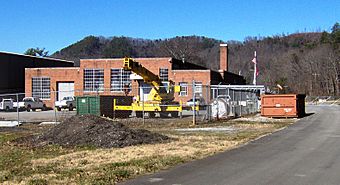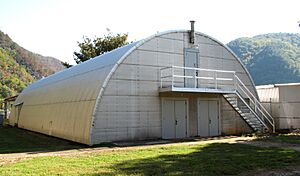Calderwood, Tennessee facts for kids
Quick facts for kids |
|
|
Calderwood Hydroelectric Development
|
|

Calderwood Dam service building
|
|
| Location | 314 Growdon Boulevard |
|---|---|
| Nearest city | Maryville, Tennessee |
| Area | 195 acres (79 ha) |
| Built | 1930–1953 |
| Architect | A.V. Karpov, Tapoco Inc. |
| Architectural style | Colonial Revival |
| NRHP reference No. | 04000545 |
| Added to NRHP | May 24, 2004 |
Calderwood was a small community that used to be located along the Little Tennessee River in Blount County, Tennessee. It was started in 1912 by the Aluminum Company of America (Alcoa). This community was a base for building and taking care of the large dams that made electricity for Alcoa's aluminum factories.
Calderwood was home to construction workers and dam maintenance staff until the 1960s. Even though most of the houses were taken down after the community was no longer used, three important buildings remain. These include the Calderwood Dam service building, the Calderwood School, and a special building called a Quonset hut that was once used as a theater. These buildings were added to the National Register of Historic Places in 2004, which means they are recognized as important historical sites.
Alcoa began building power plants in the Little Tennessee Valley around 1909. They needed huge amounts of electricity to power their aluminum factories in Blount County. An engineer named Isaac Glidden Calderwood (1871–1941) led this big project. Under his guidance, three major dams were built: Cheoah (finished in 1919), Santeetlah (finished in 1928), and Calderwood (finished in 1930). These dams were built in a very remote part of the valley, close to the Tennessee-North Carolina border.
The community was first called "Alcoa." However, the company later used the name "Alcoa" for its main company town, Alcoa, Tennessee, which was further north in Blount County. So, the construction camp was renamed "Calderwood" to honor I. G. Calderwood for his hard work.
Where Was Calderwood Located?
The Calderwood community was on the north side of the Little Tennessee River. This area is about 41 miles (66 km) upstream from where the river flows into another body of water. This part of the river is actually a section of Chilhowee Lake, which is formed by Chilhowee Dam about 8 miles (13 km) downstream.
Calderwood Dam is located about 3 miles (4.8 km) upstream from the community. It's on the other side of a big curve in the river that looks like a horseshoe. The main road to the Calderwood area is U.S. Route 129. Just past Calderwood, this road becomes a very curvy section known as "The Dragon," which is famous among motorcyclists for its many turns.
The remaining buildings of the community and the Calderwood Dam service building can be reached by Housley Road. This road connects US-129 to Growdon Road, which is right by the river. The Calderwood Baptist Church is partway down Housley Road, hidden in a wooded area. At the intersection of Housley and Growdon, the service building is to the left. A gated road, which you can walk on, continues from there to the powerhouse. To the right, the road goes past the Calderwood School building and ends at a boat ramp on the lake. Just past the school, another road goes up a hill to the Calderwood Methodist Church and where the houses used to be.
A Look Back: History of Calderwood
The area where Calderwood was built has a long history. For hundreds of years, Native Americans used a narrow part of the river here as a crossing point. In the 1700s, the Overhill Cherokee village of Tallassee was located on both sides of this river crossing. This village was destroyed by Colonel John Sevier in 1788. This happened as a response to an attack that occurred a few miles north.
When Alcoa started developing the Little Tennessee Valley around 1909, the Calderwood area was a farm owned by John Howard. Alcoa bought the land and began using it as a main base for their operations. In 1912, a post office was set up at this base camp. It was first called "Alcoa."
Under the leadership of engineer I. G. Calderwood, a railroad line was built. This connected the base camp to the Southern Railway terminal at Chilhowee. Alcoa's plans for the Little Tennessee Valley were finalized in 1915. Soon after, construction crews started arriving at the company's base camp. The Cheoah Dam was finished in 1919, and the Santeetlah Dam was completed in 1928.
In 1919, the large town that housed the workers for Alcoa's aluminum factories was officially named "Alcoa." Before that, it was known as "North Maryville." The next year, the company renamed its Little Tennessee Valley construction camp "Calderwood." This was done to honor I. G. Calderwood, who was in charge of all the operations in the valley.
After the Calderwood Dam was finished in 1930, the construction camp changed. It became a community that housed the crews who maintained the dam. Nearly two dozen homes were built, all with the same one-story design.
After World War II, the community of Calderwood grew. In 1950, a school was built. A special curved building called a Quonset hut was also brought in and used as a theater. The Calderwood Methodist Church was finished in 1954, and the Calderwood Baptist Church was completed the following year. However, within a few years, fewer workers were needed on site. People started moving away. By the late 1960s, Calderwood was mostly empty.
Remaining Historical Buildings
Calderwood Dam was added to the National Register of Historic Places in 1989. The dam's powerhouse, valve house, and tunnels were added in 1990. In 2004, several buildings in the Calderwood community were also added to the National Register. These included the dam's service building, the school, and the Quonset-hut theater. The dam's large cranes and gatehouse were also included.
All the original homes in the community have been taken down. Only their foundations and two garages remain. The Calderwood Methodist Church is still standing, but the Calderwood Baptist Church has partly collapsed. Neither church was included in the National Register listing.





